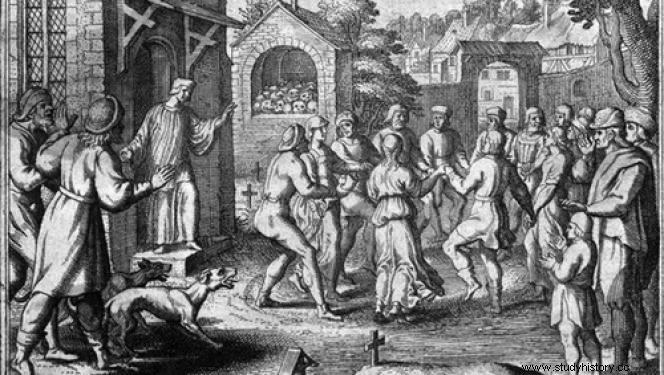When we talk about epidemics in medieval Europe or at the beginning of the Modern Age, it is inevitable that one word comes to mind:the black plague. And although it was the cause of one of the deadliest pandemics in human history, it was not the only one. English sweat, anthrax or leprosy were other diseases that devastated the European population at the time. However, there were also other deadly epidemics... some of them really out of the ordinary.

Dance, dance, damn you
In 1518 Strasbourg, in the center of Western Europe, was a population of about thirty thousand inhabitants. It did not yet belong to the crown of France, but was a free city (it would continue to be until the end of the 17th century), nor was it still called Strasbourg, but rather it was known as Argentina, a name derived from the Roman camp that was the origin of the city:Argentoratum . But more than a millennium had passed since the end of Roman times and from Strasbourg, thanks to the printing press, new ideas were spreading that would revolutionize the history of religion in Europe. Precisely that same year of 1518, the writings and theses of Martin Luther began to be published in the cathedral of this city. , and soon the city's churches would be among the first to consecrate themselves to Protestant worship.
Perhaps the religious movement and the fervor of the new humanist ideas had something to do with this story. The thing is, that summer of 1518, a woman named Frau Troffea she began to dance convulsively through the streets of the city. There was no music or an apparent reason for that dancing frenzy, but this Troffea didn't stop dancing all day... or later. Shortly after, a neighbor joined that senseless dance, and then another, and another... A week later, some thirty people danced with Frau Troffea, and in a month there were more than four hundred "infected" people who danced through the streets of Strasbourg without cause and without being able to stop. The first deaths among the dancers did not take long:heart attacks, strokes or simply exhaustion began to take their toll.
Logically, for the "unaffected" that was a mystery, nobody knew what was happening. The doctors could not find an explanation for this behavior, and the only remedy that the civil authorities were able to find was to build a large wooden floor to enable it as a "dance area" and hire musicians, thinking that if they fed their activity they would improve with the weather. And while those dancers, desperate for their situation, begged for help. They didn't want to dance! They also didn't know what was happening to them, but they couldn't stop. And while they continued to die from exhaustion or heart attacks, new neighbors fell victim to this strange dancing epidemic, joining the desperate dancers.

The choreomania
The dancing and the deaths continued until two months later, in early September, the dancing plague ended as suddenly as it had begun. Its cause was never known, there was no official explanation, nor was any cure applied, apart from the aforementioned remedy of feeding the dancing desires of those affected.
Choreomania is the name given to these epidemic episodes of psychotic dancing. Because the one in Strasbourg was not the only outbreak that took place, it is simply the most documented thanks to the written testimony left by various witnesses, including several doctors.
In fact, the oldest episode on record occurred in the seventh century, and was reappearing periodically. And most of them took place in central Europe, some with tragic consequences. Like in 1278, when some two hundred people in Germany started dancing, for no apparent reason, on a bridge over the Meuse River. The affair ended with the bridge collapsed, many dancers drowned, and the survivors taken to a nearby chapel dedicated to Saint Vitus. From there choreomania took its most popular name of San Vito dance .
However, the most widespread and massive appearance of this plague took place in 1374. It began in Aachen (Germany) and soon spread throughout the country, Cologne, Frankfurt, Metz... and to nearby countries, reaching Flanders, Luxembourg and Italy. .
To this day, the explanation for this phenomenon that suddenly ceased in the mid-seventeenth century, when the last outbreaks occurred, remains unknown. The most accepted hypothesis is that it was a mass hysteria in response to stress caused by times of famine and disease, which caused mass psychosis.
Dancing to death, an undoubtedly curious response to the misery of medieval and post-medieval Europe .
